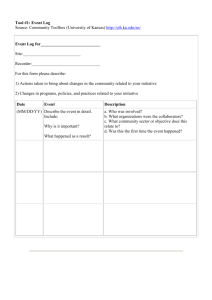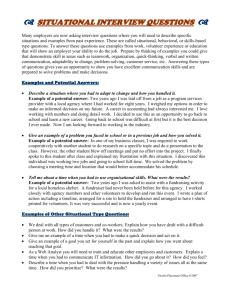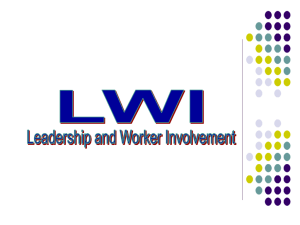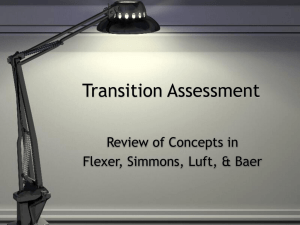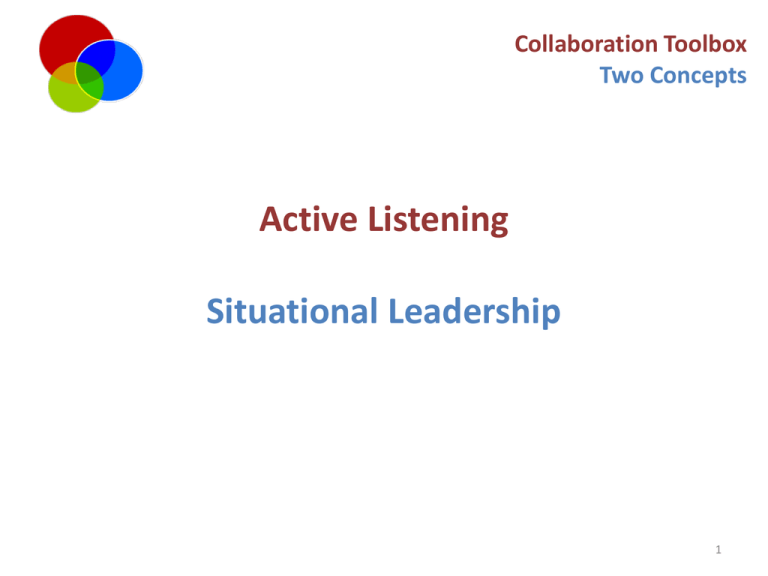
Collaboration Toolbox
Two Concepts
Active Listening
Situational Leadership
1
Collaboration Toolbox
Active Listening
Definition
Three processes involved in listening
Receiving
Processing
Sending
Thinking and considering meaning
2
Collaboration Toolbox
Active Listening
Barriers to Active Listening
Bias
Distractions
Misinterpretations
Attachment to our Opinions
Selective Hearing - Hearing only what you want to hear
Poor Communication Skills
3
Collaboration Toolbox
Active Listening
Stages of Active Listening
Clarification
Ask questions to illuminate meaning
Paraphrasing
Rephrase content
Reflection
Rephrase speaker’s feelings
Summarization
Rephrase the entire message
4
Collaboration Toolbox
Active Listening
Tips
If you are rehearsing what you are going to say
You are not active listening
5
Collaboration Toolbox
Active Listening
Exercise
1. Your team’s Oral Presenter to explain to the other team members what they know
about your project Use Active Listening Techniques to listen to the description (5
minutes)
i. Do not interrupt
ii. Ask clarifying questions when you do not understand the meaning of what
the speaker is saying
2. Team members should paraphrase
i. Allow time for the person to be silent if appropriate
ii. You do not have to jump right into the conversation
iii. Your partner may be collecting his/her thoughts
3. The recorder will summarize the discussion (5 minutes)
4. I will be calling on people at random team members to summarize (5 minutes)
6
Collaboration Toolbox
Situational Leadership
Definition
Choosing appropriate leadership
style for individuals with different
competencies
All information on slides created by: Paul Hersey, Ken Blanchard, and Seth Godin Copyright © 1979, 1998, 1993, 2001
by the Center for Leadership Studies, Inc. All rights reserved.
Collaboration Toolbox
Situational Leadership
Overview
Effective leaders will adapt their leadership style to the situation.
Team Members also adapt their developmental style to fit the
situation
Collaboration Toolbox
Situational Leadership
Concept
Leaders adapt style according to the team member’s needs
What is the current competency level for the specific task I am asking
the team member to perform?
Collaboration Toolbox
Situational Leadership
Concept
Situational Leadership
Ability
Knowledge of Task
Individual’s or Team’s
Experience and Proficiency
Willingness
Confidence
Commitment
Motivation
for Executing Assigned Task
Collaboration Toolbox
Situational Leadership
Directing
High task focus, low relationship focus
Leaders
Define Roles and Tasks for Team
Close Supervision of members
Leader makes Decisions and Manages
For team members who lack competence, but are enthusiastic
and committed and need direction and supervision to execute
the task.
Collaboration Toolbox
Situational Leadership
Coaching
High task focus, high relationship focus
Leaders still define roles and tasks
Seeks ideas and suggestions from the team member.
For team members who have some competence but lack
commitment, need support and praise to build their selfesteem, and involvement in decision-making to restore their
commitment.
Collaboration Toolbox
Situational Leadership
Supporting
Low task focus, high relationship focus
Leaders facilitate and take part in decisions
Team member exerts some control over the task
For team members who have competence, but lack confidence
or motivation and do not need much direction because of their
skills, but support is necessary to bolster their confidence and
motivation.
Collaboration Toolbox
Situational Leadership
Delegating
High Competency High Commitment
Leaders are involved in decisions and problem-solving
Team member controls execution of task
For team members who have both competence and
commitment and are able and willing to work on a project by
themselves with little supervision or support.
Collaboration Toolbox
Situational Leadership
Assessment of Leadership Styles 2015
Situational Leadership Questionnaire
Styles chosen by students under all situations
4 answers per situation:
11%
Most effective
More effective
Less effective
Least effective
23%
most effective style
more effective style
35%
31%
less effective style
least effective style
Collaboration Toolbox
Situational Leadership
Leadership Effectiveness Results 2015
Leadership Style Effectiveness Score Histogram
25
Frequency
20
15
10
5
0
25 30 35 40 45 50 55 60 65 70 75 80
Score
Score Bounds:
Always choose the least effective style: 20
Always choose the most effective style: 80
Collaboration Toolbox
Situational Leadership
How the SL Model Relates to TKI
TKI is an indicator of how you naturally manage your conflicts
While Situational Leadership is an indicator of how you naturally
manage your team
Understanding
team dynamics
Conscious of own
behavioral patterns
Adapt leadership style to meet
team expectations and accomplish project goals
Collaboration Toolbox
Situational Leadership
Trends in changes of behavior 2013
Leadership Style:
Most did not change style (3/5) when change occurred, shifted
towards low-directive
Team Motivation:
A) Shift towards high commitment as competence increased
or
B) Shift towards low commitment, as enthusiasm diminished
Collaboration Toolbox
Situational Leadership
Chocolate River Project
Designing a Bridge
Collaboration Toolbox
Situational Leadership
Chocolate River Project Instructions
1. Time: 30 minutes
2. Each Team will be given the following materials
1. Package of linguine
2. Glue Gun for Team
3. 7 Glue sticks
4. Measure for the bridge, which is an 8.5” by 11”
paper
Collaboration Toolbox
Situational Leadership
Chocolate River Project instructions
1.
2.
3.
4.
5.
Team of 3 or 4 - All must participate
First Rotation Team Leader is in charge and will assign tasks.
Find a space to build your bridge
Design your bridge
Rules
a. Must span an 8.5” span
b. Build for strength
c. Must be free standing until demonstration
d. Cannot be taped to the floor, walls or other structures.
6. Implement
Collaboration Toolbox
Situational Leadership
Chocolate River Project Objective
Prizes Will Be Awarded on the Basis of the
Strongest Bridge
Most Aesthetically Pleasing Bridge
Collaboration Toolbox
Situational Leadership
Chocolate River Project Discussion
What did you observe?
1.
2.
3.
4.
5.
6.
7.
How well did the team work together?
What do you think of your accomplishment?
What role did each team member play doing the task?
What skills did each member bring to the task?
What leadership styles did the team leader use during the planning?
What leadership styles did the team leader use during implementation?
Did you effectively communicate with each other?
Collaboration Toolbox
Situational Leadership
Conclusions
Teams do moderately well at adapting leadership style to team needs
Different situations require different leadership styles
Effective leaders account for team members’ levels of commitment and competence
Leadership style may alter across team members
Collaboration Toolbox
Situational Leadership
Suggestions for Improvements
Leaders choose a style that enhances members’ effectiveness
To Improve management assess team members’ ability and willingness
to implement the task
Use appropriate Situational Leadership style
Directing
Coaching
Supporting
Delegating
Avoid conflicts through improved communication and negotiation



